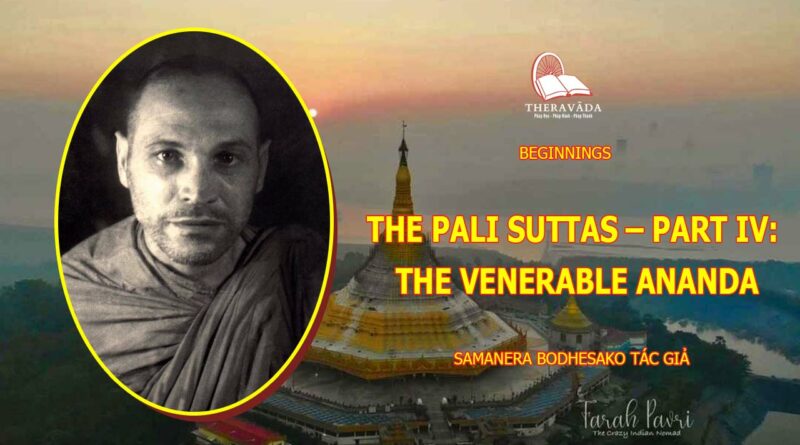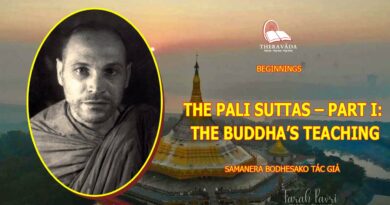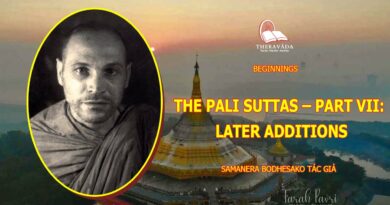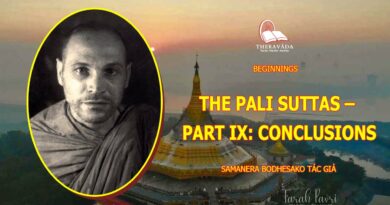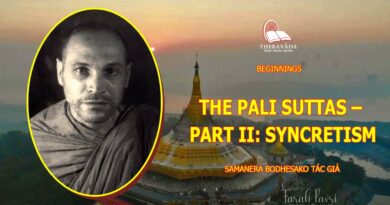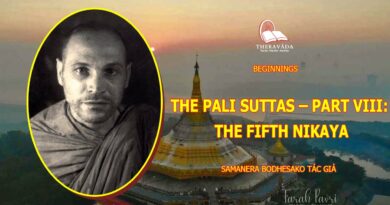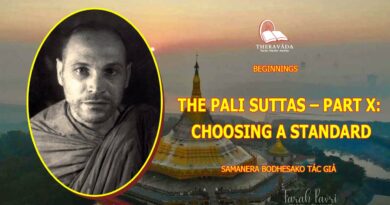BEGINNINGS: THE PALI SUTTAS – PART IV: THE VENERABLE ANANDA
Within the first year after the Buddha’s enlightenment, there entered the Order that individual who, apart from the Buddha himself, was best equipped to influence the development of the Suttas as an organized body of teachings, and to whom we therefore owe an immense debt. Without Venerable Ananda it is possible that we would not have the Suttas today at all.
Venerable Ananda, cousin of the Buddha, went forth from the lay life not long after the Buddha had visited his kinsmen, the Sakyans, at Kapilavatthu, where both had grown up; and from the time of his going forth it would seem that Venerable Ananda spent most of his time near the Buddha. Indeed, for the last twenty-five years of the Buddha’s ministry Venerable Ananda served as the Buddha’s devoted personal attendant, following him “like a shadow” — Thag. 1041-1043. He did many services for the Buddha, and he also did one for us: he listened.
At that time many people called on the Buddha: monks and nuns, lay followers, kings and ministers, even adherents of other teachers. Some asked for guidance or explanations, some made conversation or put to him prepared questions just to hear what the Buddha might say, and some even challenged and debated with him. To all, the Buddha taught about suffering and about the way to put an end to suffering. Some of these people became enlightened[13] right then and there, while listening to the Buddha: M. 140 (iii,247), etc. Others would bear in mind what had been said and, thinking it over and applying it, would achieve enlightenment at some later time: A. VIII,30 (iv,228-35), etc. Still others never succeeded to this extent but improved themselves and obtained a bright rebirth: S. XL,10 (iv,269-80), etc. And some, of course, went away without having benefited at all by their meeting: M. 18 (i,109), etc.
To all these people the Buddha spoke only about suffering and the path leading to the end of suffering, but he did so in many different ways, explaining himself using various approaches. We must all begin from where we are; but we are not all in the same place, spiritually, when we begin. Different people will respond to different forms of expression. It is important to remember, when reading these Suttas, that they were not spoken in a vacuum: there was an actual person, or people, sitting before the Buddha, and what the Buddha said was spoken with the aim of resolving a particular conflict, usually internal. If we forget this point, we leave ourselves open to the danger of misconceiving the Teaching in mechanistic terms as an impersonal explanation rather than as good advice on how to live, and on how to develop a view of things that is free from attachment and unhappiness.
So the Buddha explained about ignorance, conceit and suffering in many different ways; and Ananda was there. And he not only listened, he also remembered. So he did two services for us.
Among the monks the custom arose of teaching each other their favourite discourses through the techniques of sequential and simultaneous recitation, practices still found today. Venerable Ananda took a particular interest in talks worthy of preservation, and with his great capacity for recall[14] he learned many discourses delivered by his fellow monks, as well as those given by the Buddha, thereby increasing his value as a repository of the Teaching.[15] Since, further, he was well known as a monk who had heard much, learned much, and was approachable, willing to help whenever he could, there can be no doubt that he was often asked by others to teach them discourses or just to recite them so that they might be heard. So he taught others — e.g. S. XXII,90 (iii,133-4); A. IX,42 (iv,449) — and helped to spread the Teaching among both his contemporaries and those who followed after. This is a third service by which we are indebted to Venerable Ananda.
The question had to arise: in what form should these discourses be taught? Clearly they could not include every word that had been spoken[16] — at least not in the case of every single Sutta — lest the learning become so cumbersome as to be self-defeating. Although mindfulness is central to the practice of the Buddha’s Teaching (S. XLVI,53 (v,115)), monks were not all equally gifted in the ability to memorize: the discourses had to be put into a format conducive to their being accurately remembered, while at the same time preserving their essence as teachings.
The solution that was chosen[17] was to remove superfluous matters, to condense what had been said, to crystallize those aspects of the Teaching which are found repeatedly — the four noble truths, the eightfold path, the method of right conduct, restraint of the faculties, mindfulness, the various levels of meditation, the five aggregates, dependent origination, and so on — into the most concise descriptions possible, to couch the whole of this into a set pattern conducive to memorization, and to introduce as much repetition and re-iteration as possible. A typical Sutta, then, will begin by telling where the discourse took place, it will introduce the person or persons concerned and provide us with any other information necessary; then the theme will be stated concisely; each aspect of the theme will then be brought forward in its turn, repeated, developed with a copious use of synonyms, expanded, summarized and re-iterated. Similes may be introduced, in which case by means of parallel construction with the subject matter their relevance will be unmistakable. Each possible permutation will be dealt with in turn, the opening thematic statement will be recapitulated, and the Sutta will then conclude with remarks usually of approval and pleasure. The purpose is clear: to make absolutely certain that the matter at hand is stated so clearly that an intelligent person, open-minded, willing to listen, not bent on his own views, could not possibly misunderstand.[18] Thus the arising of stock material and techniques, and also their spread, as they came into usage among the various companies of monks that flourished, took place during and not only after the Buddha’s ministry, although, as we shall see, their influence was with limitations: there were those companies that kept to their own forms.
Some find the Suttas, with all of their re-iteration, excruciatingly boring. “This,” they suggest, “could hardly be the message of a Fully Enlightened One.” They suppose that because they themselves are not enthralled that therefore the message cannot be that of a Buddha. Not only do they fault the method, but the message as well; for were the message — renunciation — delightful to them, its repetition would hardly be objectionable. But when the idea of non-attachment is appreciated and approved of, then in both their message and their method the Suttas will be found to be both memorable and rememberable.[19]
Source: Budsas.net

